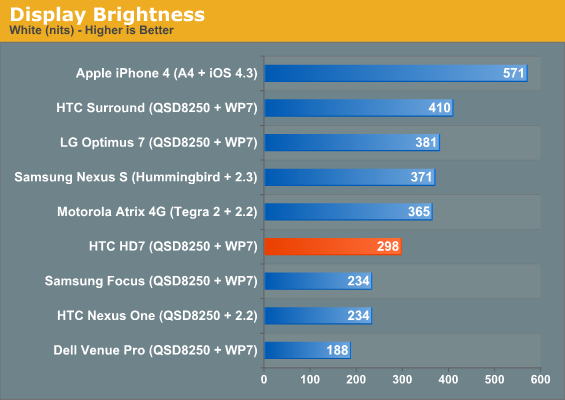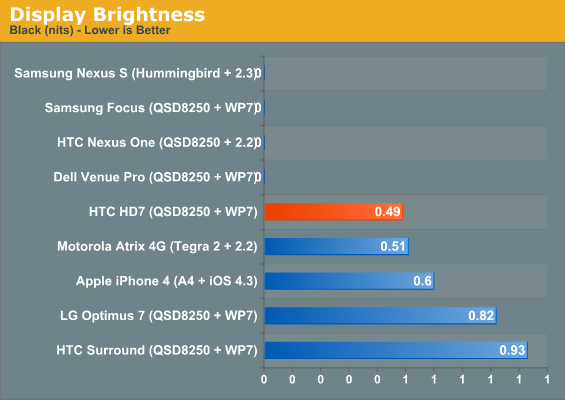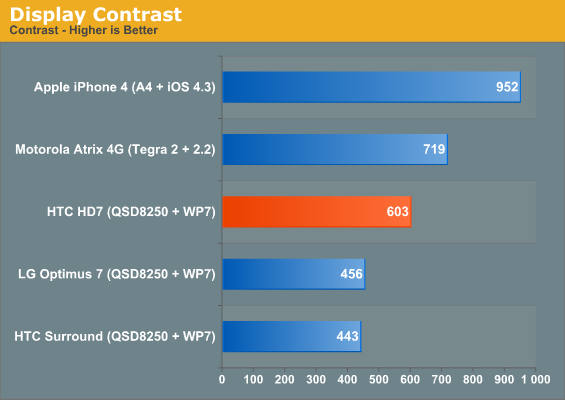HTC HD7: Now With NoDo
by Vivek Gowri on May 12, 2011 6:30 AM EST- Posted in
- Smartphones
- Windows Phone 7
- Snapdragon
- Mobile
- HTC HD7
The Trusty Old 4.3” WVGA
The above headline read “The Good Old 4.3” WVGA” until I realized that HTC’s 4.3” WVGA LCD panel is pretty mediocre at this point. It has size on its side, but brightness and contrast are middling at best. It’s not bad, but compared to the cream of the modern smartphone crop, it’s just not that competitive.



The upcoming HD7S for AT&T changes that, with a Super-LCD version of the same 4.3” display (the S stands for Super). We’ve seen pretty good performance out of S-LCD displays in the past, and assuming the HD7S continues that trend, it’ll have a decent display.
Thankfully, HTC is moving to S-LCD for the 4.3” qHD devices (Sensation and EVO 3D), but that brings up a larger question for Microsoft—with most of the high end Android devices moving to dual core processors and higher resolution qHD displays and Apple already with a high res screen and moving to a dual core SoC in the near future, when will Microsoft decide to take the next step to compete on the bleeding-edge hardware level?
1GHz Snapdragons and WVGA displays were high end in mid-2010. A year later, they’re still good enough for most smartphone users, but what about the high end market now? Most indications I’ve seen out of Microsoft seem like there will just be a bump to the 2nd generation 45nm Snapdragon chips for the second generation WP7 devices. Those will probably hit late this year, around the same time as the 5th generation iPhone and the next wave of dual-core Android phones (not to mention quad-core tablets), so WP7 handsets will still be lagging far behind the competition.
It’s a twofold problem. One is that Microsoft’s tight control of the system is creating the reverse effect of the fragmentation problems afflicting Android. While there’s a lot of software diversity in Android phones, there’s an equal amount of hardware diversity. With WP7, there’s zero software diversity, and correspondingly little hardware diversity as well. HTC has five different WP7 handsets on the market—one has a slide-out keyboard, one has a slide-out speaker, one has a marginally larger screen, but other than that, they’re all practically the same. The biggest differentiating factor from device to device is the type of screen it has; beyond that, all ten WP7 devices have nearly identical hardware.
Microsoft’s desire to keep a consistent experience across all Windows Phones is an admirable goal, but there’s only one way to do that and stay with the times technologically, which brings me to the second problem. They need to iterate faster, and not just on the software end (though I’ll address that on the next page). Microsoft is still playing catch up in the smartphone game, and matching Apple’s release schedule will not get them caught up. There either needs to be a large number of smaller iterations (Google-style, a new OS revision and new handsets every four months) or, really significant steps forward every 12 months. The former is where NoDo comes in.










44 Comments
View All Comments
damianrobertjones - Thursday, May 12, 2011 - link
I don't want a super resolution phone with S-lcd or two processors...What I DO WANT is a much, much larger battery. I'm sick and tired of charging the thing nearly every single day. Sure, I've lived with the situation since the Qtek days but the HD7 (and HD2) that's in front of me does take the biscuit.
Also, HTC, stop designing the back of your phones so the people in China can't make a suitable cover for their extended batteries. Either do it yourself or design well.
AggHhhhgghg
Crono - Thursday, May 12, 2011 - link
As a Dell Venue Pro owner/user, I have to agree with all the points in this article about Windows Phone 7.In one sense, Microsoft stepped forward with their new phone platform to come close to what Apple has done with iOS, even (dare I say) surpassing Apple with some features and elements of the GUI.
But they have done so by limiting the options available. It's as if Microsoft gave up the "Windows" aspect and really just went the Apple route, albeit in their own way. Microsoft has always been apt to learn from/copy the innovations of other companies, but it seems like they gave up a bit much in recreating a Windows branded platform over the ashes of the old Windows Mobile. I find it odd that Google's Android OS is more akin to Windows than WP7 is. I miss the "power" options that the Windows Mobile/CE phones and PDAs had, like the ability to close and switch between apps and the ability to overclock/underclock with an application, among other things.
Trefugl - Thursday, May 12, 2011 - link
I don't find it odd that Android is "more akin to Windows than WP7" assuming that you are referring to the openness/scalability and "power user" aspects. Google comes from a Linux mindset, and Linux has always been that way... what is amazing is that Google has managed to polish Android to the point that the average user finds it accessible (much like they do Windows).I always hoped that Microsoft could find a balance between Google and Apple's approaches, but they are still just too far behind. At this rate, Google will manage to provide an appropriately structured environment for their userbase before WP7 is relevant in terms of market share and features. (This comes from a guy who had high hopes for WP7)
Flunk - Thursday, May 12, 2011 - link
I have an HTC HD7 and I can see your point. Windows Phone 7 is more of an offshoot of Xbox and Zune than a successor to Windows Mobile. It's not designed to be the most flexible pocket computer it can be but instead focuses on doing common tasks well and quickly.I used to use Windows Mobile and I think this is the way to go for a phone. Sure I can't use it to code Java programs, but it's much better at things I normally use my phone for.
Stuka87 - Thursday, May 12, 2011 - link
For the Black level, isn't lower better? This graph seems to the opposite of the ones we normally see.Spivonious - Thursday, May 12, 2011 - link
I just wanted to point out that "NoDo" was done in January. It was carrier testing that has delayed it.For other readers, watch the videos from this year's MiX to see what Mango contains. If MS really puts some marketing muscle behind it, it really has a good chance of knocking the iPhone out of second place.
Stuka87 - Thursday, May 12, 2011 - link
You are aware that the iPhone is in first place right? Well, unless you compare all Android devices against the single iPhone device (rather than iOS devices).But even if you do measure it incorrectly like that, WP7 would need to have the single largest sales increase of any device in history to even get close to Android or iOS.
duffman55 - Thursday, May 12, 2011 - link
It's trivial to compare the number of users of an individual smartphone model, unless you're going to be holding some sort of smartphone popularity contest.What's important is the number of users of the OS. Developers are more likely to develop for a platform with more users.
You're right, WP7 does have a ways to go to compete with the likes of Apple and Google. It's going to be a while, but I think they'll get there eventually.
Vivek, I noticed "it's" was used where it should have been "its" a few times in the article. I don't mean to nitpick, just letting you know :)
VivekGowri - Friday, May 13, 2011 - link
Really? I'm usually better about that. Damn English grammar, lol.earle36 - Thursday, May 12, 2011 - link
I really have to disagree with part of the conclusion here... I have been using a Samsung Focus for several months and love the OS. I don't need custom ring tones - sure its 2011 and they don't offer custom ring tones - big deal. I'd rather they focus on ACTUAL core OS improvements rather than extras like custom ring tones. And mango will offer several improvements to the OS. Within one year they will have added copy paste, improved app loading, new browser, multitasking, messenger integration, and so on. That is huge. I understand that they are just playing catch up - but that's what happens when you release a completely new mobile OS. Several months ago Anandtech published reviews of the WP7 devices and and the WP7 OS - knowing full well what it did and didn't offer, and what the next year was to offer. The reviews were very positive when looking at the big picture. Fast forward to today, MS has delivered exactly what they said they would and (as of now) are on track to deliver some MAJOR improvements to the OS, and now its not enough? What changed?